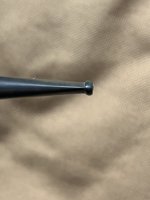This is for you oldie Dunhill shoppers.
The info applies from the late(ish) 1920s through the late 60's / early 70's for all but special orders, specialty pipes, giants, etc.
The following pics show an authentic stem for a 1940's model 475 (as a reference), and a good copy and a bad copy for the same pipe---a 1956 475.
The authentic one will NOT fit the 1956 pipe---the shank & overall size of the two pipes are different (the '56 is slightly larger)---but since pointing out the "tells" of a replacement stem is the point of this thread, that doesn't matter.
The first thing to look for and the easiest to spot is the crisp 45-degree angle between the tenon and shank face. Before the 1970's, Dunhill never used a square or rounded cut here.

Next is the button's front-on profile. Legit Dunhill stems are always a flattened oval with rounded ends NOT Stewie Griffin points.

The overall side-taper rate is also important. Notice that the stem on the left is neither straight nor fish tail, but somewhere in between. Older Dunhill's were pretty strict about being one or the other. (No F/T stamp means almost (but not quite) parallel-sided for the full length of the stem, and having the F/T stamp means an unambiguous bite-zone flare or "trumpet" shape when viewed from the top.)
All these are non F/T stems.
Also, both the dot placement (it's too close to the shank) and the dot size (it's too large) are wrong on the left one. Those two things vary enough from specimen to specimen that there's no standard, however. You just have to look at enough authentic pipes that after a while an estate pipe's dot either "looks right" or it doesn't.
Also, though not definitive, but helpful, is the COLOR of the dot.
Notice that the one on the right is very faintly---but distinctly---yellow-ish. Sort of a translucent cream color. That's because a percentage of legit oldies had their cellulose dots do that from age.
Because I like the look, I "fake" it with walrus ivory (the only other option is to use cellulose and wait 50+ years and hope you handled the pipe in whatever ways caused SOME Dunhill dots to do that.)
Anyway, if the dot is a translucent-ish cream color, the stem is almost guaranteed to be original. Remember that the reverse is NOT true, however.

Finally, the side profile of the button.
It is very difficult to get right, so almost never is on replacements.
Rather than try to describe the characteristics, I'll just let the picture do the talking.

PS --- the side view of the entire stem is the most basic tell of all---Dunhill NEVER did the duckbill thing---but anyone reading this almost certainly already knows that. I wanted to cover the more subtle stuff.
The info applies from the late(ish) 1920s through the late 60's / early 70's for all but special orders, specialty pipes, giants, etc.
The following pics show an authentic stem for a 1940's model 475 (as a reference), and a good copy and a bad copy for the same pipe---a 1956 475.
The authentic one will NOT fit the 1956 pipe---the shank & overall size of the two pipes are different (the '56 is slightly larger)---but since pointing out the "tells" of a replacement stem is the point of this thread, that doesn't matter.
The first thing to look for and the easiest to spot is the crisp 45-degree angle between the tenon and shank face. Before the 1970's, Dunhill never used a square or rounded cut here.

Next is the button's front-on profile. Legit Dunhill stems are always a flattened oval with rounded ends NOT Stewie Griffin points.

The overall side-taper rate is also important. Notice that the stem on the left is neither straight nor fish tail, but somewhere in between. Older Dunhill's were pretty strict about being one or the other. (No F/T stamp means almost (but not quite) parallel-sided for the full length of the stem, and having the F/T stamp means an unambiguous bite-zone flare or "trumpet" shape when viewed from the top.)
All these are non F/T stems.
Also, both the dot placement (it's too close to the shank) and the dot size (it's too large) are wrong on the left one. Those two things vary enough from specimen to specimen that there's no standard, however. You just have to look at enough authentic pipes that after a while an estate pipe's dot either "looks right" or it doesn't.
Also, though not definitive, but helpful, is the COLOR of the dot.
Notice that the one on the right is very faintly---but distinctly---yellow-ish. Sort of a translucent cream color. That's because a percentage of legit oldies had their cellulose dots do that from age.
Because I like the look, I "fake" it with walrus ivory (the only other option is to use cellulose and wait 50+ years and hope you handled the pipe in whatever ways caused SOME Dunhill dots to do that.)
Anyway, if the dot is a translucent-ish cream color, the stem is almost guaranteed to be original. Remember that the reverse is NOT true, however.

Finally, the side profile of the button.
It is very difficult to get right, so almost never is on replacements.
Rather than try to describe the characteristics, I'll just let the picture do the talking.

PS --- the side view of the entire stem is the most basic tell of all---Dunhill NEVER did the duckbill thing---but anyone reading this almost certainly already knows that. I wanted to cover the more subtle stuff.























